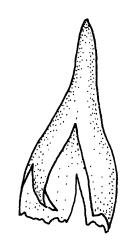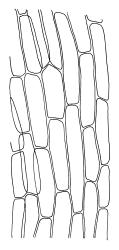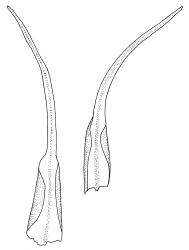Plants small, yellow-green. Stems 1–4(–15) mm, unbranched or occasionally branched by innovation. Leaves erect-spreading, sheathing below, ± contorted when dry, distinctly shouldered and abruptly tapered from an oblong, concave and strongly sheathing base to a narrow subula that is completely filled by the costa and up to ⅔ the total leaf length, entire, to c. 2.5 mm (in perichaetium) but shorter (≤1 mm) on lower stem. Laminal cells of leaf base to c. 65(–75) × 18 µm. Costa (in leaves immediately below the perichaetium) occupying c. ⅙ the width of the base, completely filling the subula, in cross-section (lower subula) with median guide cells and abaxial and adaxial bands of smaller but non-stereid cells.
Apparently dioicous (but male plants clustered near to female and possibly rhizautoicous). Setae mostly 2.5–5 mm, stout, flexuose, pale. Capsules c. 1.5–1.9 mm, weakly curved or nearly straight, erect or inclined, with the neck equal the obovoid urn, strongly strumose; exothecial cells oblong-polygonal; annulus persistent at mouth; operculum rostrate from a conic base, c. ½ capsule length. Peristome teeth variable in development, brown, inserted near mouth, broadly triangular to short-lanceolate, blunt or acute, mostly split or perforate c. halfway to base but sometimes undivided, extending 120–180 µm beyond mouth and c. 40–60 µm wide, coherent at base, strongly reflexed when dry, striate below. Calyptra mitrate or cucullate, covering the operculum and upper portion of urn. Spores 30–36 µm, coarsely baculate.
Wilson 1859, tab. 172, fig. 6; Sainsbury 1955, pl. 14, fig. 2; Seppelt 2004, fig. 35.
NI: Taranaki (near Manganui Hut); SI: Nelson, Marlborough (Mt Stokes, Mt Fishtail), Canterbury (Arthur’s Pass), Otago (Pine Hill near Dunedin, Old Man Range, Rock and Pillar Range, Crown Range, Ben Lomond), Southland (Murchison Range, Borland Burn); M. Reported from A by Vitt (1979).
Austral (but not known from South America). Tasmania*, Marion I.*. Reported from southern mainland Australia by Scott & Stone (1976, p. 164).
On mineral soil (often coarse gravel) or peat; often at stream or tarn margins, associated with cushion bogs, or occurring on granitic gravel in seepages. Sometimes in intermittent rain tracks. Observed at the Hope Range, Nelson L.D. forming emergent turves over granitic gravel in a very shallow rivulet with Tetrodontium brownianum in subalpine tussock grassland. On South I. occurring from 450 (Pine Hill) to c. 1250 m (Mt Euclid, Nelson L.D.) but localities below c. 750 m are all near Dunedin. Often associated with Blindia robusta.
The stems are commonly less than 5 mm, but occasional populations, perhaps growing in depositional environments, occur in which the stems ramify by innovation (e.g. A.J. Fife 7463 from Hope Range, Nelson L.D., CHR 406906). The extent of the division of the peristome teeth varies considerably within a population, and even within a single capsule. Although variable in these characters, T. flexipes is a well-defined species in a N.Z. context. Despite it having sometimes mitrate calyptrae and relatively short setae and capsules, the present species is a more robust plant than described for the genus Eobruchia W.R. Buck (Buck 1979) and detailed comparison to that exceedingly rare, mostly South American genus does not seem worthwhile in a flora context.










